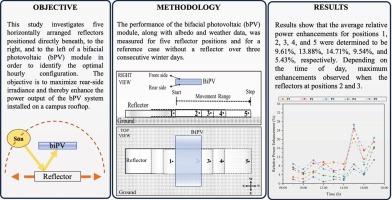Impacts of reflector positioning on horizontal bifacial photovoltaic module performance: an experimental case study
IF 7
2区 工程技术
Q1 ENERGY & FUELS
Sustainable Energy Technologies and Assessments
Pub Date : 2025-09-16
DOI:10.1016/j.seta.2025.104578
引用次数: 0
Abstract
Bifacial photovoltaic (bPV) technology, which converts solar irradiance from both the front and rear surfaces into electricity, represents a promising solution for enhancing solar energy conversion. While numerous studies have explored bPV performance under different environmental and geometric conditions, limited research has addressed the influence of horizontal reflector placement for horizontally mounted bPV modules, particularly under real-world conditions. This study fills that gap by experimentally evaluating the effect of five horizontal reflector configurations on the electrical performance of a bPV module. The experiments were carried out over three consecutive winter days on the rooftop of a university campus in Istanbul, Türkiye. Performance metrics included power yield and electrical efficiency, along with ambient temperature, relative humidity, wind speed, and module surface temperature. Results demonstrated that reflector positioning significantly influences performance, with reflector positions 2 and 3 consistently delivering the highest power output and efficiency. Average relative increases in power yield were 9.61 %, 13.88 %, 14.71 %, 9.54 %, and 5.43 % for positions 1 through 5, respectively. Corresponding average electrical efficiencies for positions 0 through 5 were 22.91 % (no reflector), 25.14 %, 26.08 %, 26.31 %, 25.12 %, and 24.18 %. These findings suggest that proper reflector placement enhances irradiance availability on the rear side of the module, particularly at low solar elevation angles, leading to notable improvements in performance. The study provides valuable experimental data under realistic conditions and contributes to the design optimization of bifacial PV systems, supporting the advancement of renewable energy technologies aligned with Sustainable Development Goals.

反射器定位对水平双面光伏组件性能的影响:实验案例研究
双面光伏(bPV)技术,将太阳辐照度从前后表面转化为电能,代表了提高太阳能转换的一个有前途的解决方案。虽然有许多研究探讨了bPV在不同环境和几何条件下的性能,但有限的研究解决了水平反射器放置对水平安装bPV模块的影响,特别是在实际条件下。本研究通过实验评估五种水平反射器配置对bPV模块电性能的影响来填补这一空白。实验是在土耳其伊斯坦布尔一所大学校园的屋顶上连续三天进行的。性能指标包括发电量和电气效率,以及环境温度、相对湿度、风速和模块表面温度。结果表明,反射器的位置显著影响性能,反射器位置2和3始终提供最高的功率输出和效率。位置1到位置5的平均相对功率增长分别为9.61%、13.88%、14.71%、9.54%和5.43%。相应位置0到5的平均电效率分别为22.91%(无反射器)、25.14%、26.08%、26.31%、25.12%和24.18%。这些发现表明,适当的反射器放置可以提高模块背面的辐照度,特别是在太阳仰角较低的情况下,从而显著提高性能。该研究在现实条件下提供了有价值的实验数据,有助于优化双面光伏系统的设计,支持符合可持续发展目标的可再生能源技术的进步。
本文章由计算机程序翻译,如有差异,请以英文原文为准。
求助全文
约1分钟内获得全文
求助全文
来源期刊

Sustainable Energy Technologies and Assessments
Energy-Renewable Energy, Sustainability and the Environment
CiteScore
12.70
自引率
12.50%
发文量
1091
期刊介绍:
Encouraging a transition to a sustainable energy future is imperative for our world. Technologies that enable this shift in various sectors like transportation, heating, and power systems are of utmost importance. Sustainable Energy Technologies and Assessments welcomes papers focusing on a range of aspects and levels of technological advancements in energy generation and utilization. The aim is to reduce the negative environmental impact associated with energy production and consumption, spanning from laboratory experiments to real-world applications in the commercial sector.
 求助内容:
求助内容: 应助结果提醒方式:
应助结果提醒方式:


